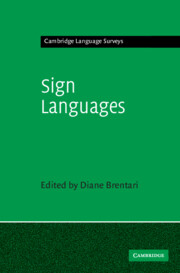Book contents
- Frontmatter
- Contents
- List of figures
- List of tables
- List of contributors
- List of sign language abbreviations
- Notational conventions
- 1 Introduction
- I HISTORY AND TRANSMISSION
- II SHARED CROSSLINGUISTIC CHARACTERISTICS
- III VARIATION AND CHANGE
- 18 Sign languages in West Africa
- 19 Sign languages in the Arab world
- 20 Variation in American Sign Language
- 21 Sociolinguistic variation in British, Australian and New Zealand Sign Languages
- 22 Variation in East Asian sign language structures
- 23 Crosslinguistic variation in prosodic cues
- 24 Deixis in an emerging sign language
- 25 The grammar of space in two new sign languages
- Notes
- References
- Index
20 - Variation in American Sign Language
from III - VARIATION AND CHANGE
Published online by Cambridge University Press: 05 June 2012
- Frontmatter
- Contents
- List of figures
- List of tables
- List of contributors
- List of sign language abbreviations
- Notational conventions
- 1 Introduction
- I HISTORY AND TRANSMISSION
- II SHARED CROSSLINGUISTIC CHARACTERISTICS
- III VARIATION AND CHANGE
- 18 Sign languages in West Africa
- 19 Sign languages in the Arab world
- 20 Variation in American Sign Language
- 21 Sociolinguistic variation in British, Australian and New Zealand Sign Languages
- 22 Variation in East Asian sign language structures
- 23 Crosslinguistic variation in prosodic cues
- 24 Deixis in an emerging sign language
- 25 The grammar of space in two new sign languages
- Notes
- References
- Index
Summary
Introduction
Even casual observation reveals that language users sometimes have different ways of saying or signing the same thing. Variation may be realized at all different levels of a language. English, for example, contains numerous examples of variation in the lexicon. Some American speakers use the word couch, while others say sofa or davenport. American Sign Language (ASL) also exhibits many well-known examples of lexical variation. For example, a number of signs exist for the concepts BIRTHDAY, PICNIC or HALLOWEEN.
At the phonological level, variation exists in the individual segments that make up words or signs or in parts of those segments. For example, speakers of a wide range of English dialects sometimes delete the final consonant of words that end in consonant clusters such as test, round or past, the result being tes', roun' and pas' (Labov et al. 1968, Guy 1980). In ASL, phonological variation can be seen in all of the parts that make up signs – in the handshape, movement, location and palm orientation, and sometimes even in the nonmanual features that are part of sign production. The basic structure of these parts is discussed in other chapters of this volume.
Variation may also occur in the morphological and syntactic components of a language. For example, in African American Vernacular English (AAVE), the copula be is variably deleted, and the sentences He is my brother and He my brother both occur.
- Type
- Chapter
- Information
- Sign Languages , pp. 451 - 475Publisher: Cambridge University PressPrint publication year: 2010
- 7
- Cited by

